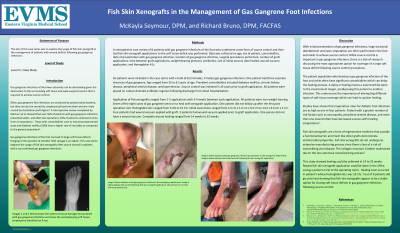Case Series/Study
(CS-032) Fish Skin Xenografts in the Management of Gas Gangrene Foot Infections

McKayla Seymour, DPM
Introduction: Gas gangrene infections of the lower extremity can be devastating. Those with comorbidities such as immunocompromised state and diabetes mellitus (DM) have a higher rate of mortality as compared to the general population1. Often, patients with lower extremity gas gangrene infections present to the Emergency Department with a septic picture. Gas gangrene infections of the foot can lead to large soft tissue defects bringing in the question of whether limb salvage is an option. This case series explores the usage of fish skin xenografts in patients with gas gangrene infections.
Methods: A retrospective case series of 8 patients with gas gangrene infections of the foot treated with fish skin xenograft applications was performed. Data was collected on age, sex of patient, comorbidities, date of presentation with gas gangrene infection, location of gas gangrene infection, surgical procedures performed, number of graft applications, time between graft applications, weight-bearing protocol, antibiotics, size of wounds with each graft application, date healed, wound vacuum application, and Hemoglobin A1c.
Results: Six patients were included in the case series with a total of 8 (2 females, 4 males) gas gangrene infections (one patient with three separate instances of gas gangrene). Age ranged from 35 to 61 years of age. Prevalent comorbidities included DM, chronic kidney disease, peripheral arterial disease, and hypertension. Source control was initiated in all cases prior to graft application. All patients were placed on culture directed antibiotic regimens following discharge from initial hospitalization. Application of fish skin xenografts ranged from 1-5 applications with 3-4 weeks between each application. All patients were non-weight-bearing. Seven of the eight cases of gas gangrene went on to heal with xenograft application. One patient had unknown healing status. Hemoglobin A1c ranged from 6.4 to 15.1. Complete wound healing ranged from 14 weeks to 32 weeks.
Discussion: While source control is important in gas gangrene infections, there is a lack of evidence for the most appropriate option for large soft tissue deficits following source control procedures. Fish skin xenografts appear to be a viable option for closing soft tissue deficits in gas gangrene infections.
Trademarked Items:
References: 1. Buboltz JB, Murphy-Lavoie HM. Gas Gangrene. [Updated 2023 Jan 30]. In: StatPearls [Internet]. Treasure Island (FL): StatPearls Publishing; 2023 Jan-. Available from: https://www.ncbi.nlm.nih.gov/books/NBK537030/
Methods: A retrospective case series of 8 patients with gas gangrene infections of the foot treated with fish skin xenograft applications was performed. Data was collected on age, sex of patient, comorbidities, date of presentation with gas gangrene infection, location of gas gangrene infection, surgical procedures performed, number of graft applications, time between graft applications, weight-bearing protocol, antibiotics, size of wounds with each graft application, date healed, wound vacuum application, and Hemoglobin A1c.
Results: Six patients were included in the case series with a total of 8 (2 females, 4 males) gas gangrene infections (one patient with three separate instances of gas gangrene). Age ranged from 35 to 61 years of age. Prevalent comorbidities included DM, chronic kidney disease, peripheral arterial disease, and hypertension. Source control was initiated in all cases prior to graft application. All patients were placed on culture directed antibiotic regimens following discharge from initial hospitalization. Application of fish skin xenografts ranged from 1-5 applications with 3-4 weeks between each application. All patients were non-weight-bearing. Seven of the eight cases of gas gangrene went on to heal with xenograft application. One patient had unknown healing status. Hemoglobin A1c ranged from 6.4 to 15.1. Complete wound healing ranged from 14 weeks to 32 weeks.
Discussion: While source control is important in gas gangrene infections, there is a lack of evidence for the most appropriate option for large soft tissue deficits following source control procedures. Fish skin xenografts appear to be a viable option for closing soft tissue deficits in gas gangrene infections.
Trademarked Items:
References: 1. Buboltz JB, Murphy-Lavoie HM. Gas Gangrene. [Updated 2023 Jan 30]. In: StatPearls [Internet]. Treasure Island (FL): StatPearls Publishing; 2023 Jan-. Available from: https://www.ncbi.nlm.nih.gov/books/NBK537030/

.png)